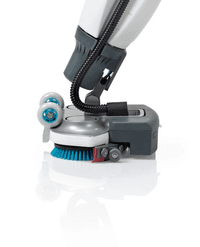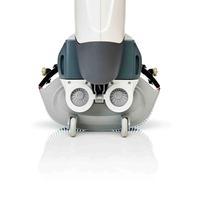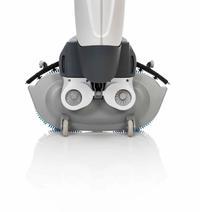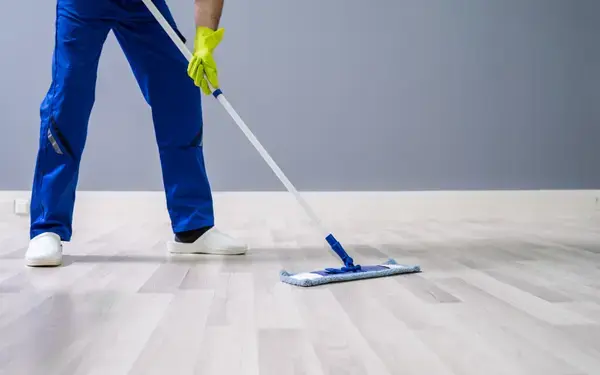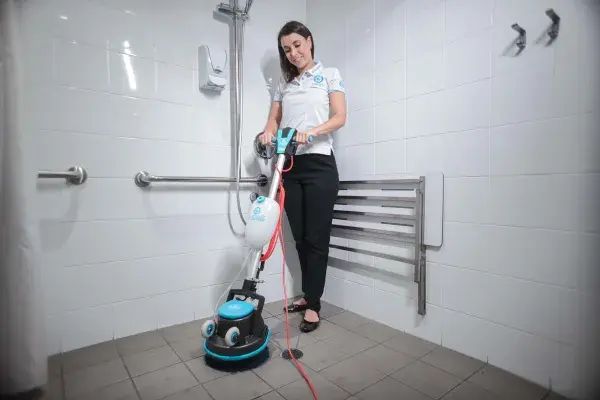You are reading: The Complete Guide to Cleaning Dirty Grout Lines
17 January 2023
8min read time
Brooke Payne
The Complete Guide to Cleaning Dirty Grout Lines
Share:

Key Insights
- Grout is highly porous so can easily harbor more dirt and grime then other surfaces
- Use the correct chemicals, tools and scrubbing technique for the job
- Consider using an automatic scrubber for areas that require more pressure or a deeper clean
Why is my grout dirty?
Often the tiled areas in our workplace or homes are high traffic areas. Grout is highly porous which means that it is likely to harbour and absorb mold, stains, dirt and grime deep under the surface. Tiled surfaces are often missed with usual cleaning routines as wiping over it with a damp cloth or mop is not enough to get rid of stains or marks.

How do I clean grout lines?
If your grout is dirty there is an effective way to clean it quickly and thoroughly.
Use the right equipment:
For cleaning grout lines on your walls, you can purchase a grout brush or deck scrub from most hardware or supermarket stores. You will also need some good tile & grout cleaning chemicals to clean the surface thoroughly. A Manual cleaning process will need a good amount of elbow grease, but as long as you don’t need to do it too often you might be ok with that.
If you do want to clean more regularly, or for larger tiled floor surfaces, a floor scrubber like the i-mop makes cleaning grout lines a breeze. Using innovative technology, the i-mop removes up to 97% of dirt compared to the traditional mop and bucket. It also leaves floors dry within seconds which can prevent further bacteria build up on your tiles.
Apply the chemicals:
i-team supply cleaning detergent to use specifically with your i-mop for cleaning based on the different flooring areas of your home or workplace. This includes the E52 Daily Floor Cleaner for daily use, E33 Sanitary Floor Cleaner for limescale and scum build up, and the E73 Degreasing Floor Cleaner for kitchen areas and workshops.
For areas where the i-mop floor scrubber cannot reach simply apply your preferred cleaning chemical to the wall tile surface and let it sit for approximately 10-15 minutes. This helps loosen the surface dirt and penetrate stains or marks. Just don’t let the chemical dry before rinsing it off.
Scrub the grout:
Use the i-mop to scrub the floor and agitate the tile and grout areas. For a deeper clean, turn the i-mop vacuum motor off. By doing so the i-mop will apply the solution and scrub the floor. If required, make several scrubbing passes.
For other surfaces, use the grout brush to scrub along the grout lines on your wall. Use firm, circular motions and ensure the cleaning solution doesn’t dry out. Simply use more solution and warm water to keep the area damp.
Rinse with warm water:
Once you have done all the deep scrubbing required, simply turn the i-mop to the normal mopping mode with the vacuum motor on and do another pass over the floor. This will pick up all the dirty soil and solution. The i-mop leaves floors dry within seconds, so there is no need to rinse or dry the floors after cleaning.
For all other surfaces, thoroughly rinse with warm water to remove all excess grime and dirt.
Read: 5 Common problems with the i-mop and how to avoid them.
How do I prevent dirty grout?
The best measures to prevent dirty grout is by consistently cleaning the grout surfaces. By prolonging regular cleans to your tiles and grout, surfaces become tougher to clean. Sweeping can also push dirt and grime into the grout. Vacuum grout lines to prevent build up which will reduce further marks and stains. Finally, avoid hand mopping as it can often result in water pooling in grout lines.
Read: Raising hotel cleaning standards with the i-mop.

Top tips to keep your grout clean
- Alkaline solution is the best for removing dirt in general areas and lifting greasy soils in grout lines, while an acidic-based solution provides the best results for tiles and grout lines in bathrooms and showers.
- Do not overuse chemicals as the i-mop brushes will do most of the work in cleaning the grout surfaces.
- Seal your grout once cleaned and thoroughly dried to keep bacteria and mold away.
- Place floormats at entry-points into your home or office to reduce the amount of dirt that will be brought into the environment.
In conclusion, cleaning grout lines can be a daunting task, but with the right tools and techniques, it can be made much easier and become far more manageable. For more information on the i-mop and or to book a demo click here !
Common Questions Answered
1. What causes grout to become dirty?
Answer: Grout is porous, which means it easily absorbs dirt, liquids, and grime over time. This is especially common in high-traffic areas like kitchens, bathrooms, and entryways, where moisture and spills are frequent.
2. Can you use bleach to clean grout?
Answer: While bleach can be used to clean grout, it should be used sparingly as it can weaken the grout and cause discoloration over time. A better option is a pH-neutral cleaner designed specifically for tile and grout or using a baking soda and vinegar mixture.
3. What tools are best for cleaning grout?
Answer: The best tools for cleaning grout include a stiff-bristled brush or a grout-specific cleaning tool. Avoid using metal brushes, as they can damage the grout. Steam cleaners can also be effective for deep cleaning without the use of harsh chemicals.
References
Bob Vila – How to Clean Grout
URL: https://www.bobvila.com/articles/how-to-clean-grout/
The Spruce – The Best Way to Clean Grout
URL: https://www.thespruce.com/best-way-to-clean-grout-1901122
This Old House – Grout Cleaning Tips
URL: https://www.thisoldhouse.com/flooring/21018438/how-to-clean-grout
Products Featured Inside this Article
Media and Insights
Join the movement that's changing what clean means.
Be part of a cleaner world. Get a live demo at a time that suits you.
Book a Demo